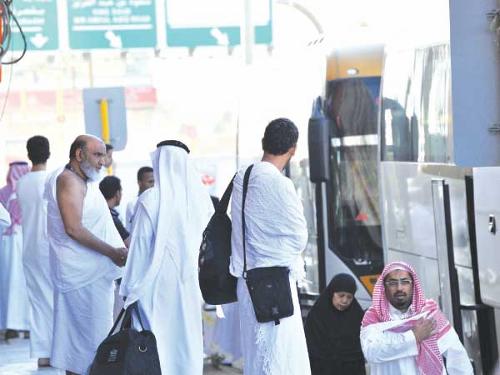Marking the beginning of the annual pilgrimage of Haj on Thursday, around two million pilgrims headed through packed streets of Makkah and surrounding cities including Jeddah and Taif to the enormous Tent City of Mina, located 7 km north east of the Grand Mosque. In a dense sea of humanity, men in seamless white clothes and women in robes and headscarves were heard chanting the talbiyah “Labbaik Allahumma Labbaik (O God, here I am answering your call)…”
After performing Isha (night) prayers at the Grand Mosque on Wednesday, they started streaming into the Mina valley. Most pilgrims embarked their life-time journey on board buses arranged by their respective tawafa organizations while some others preferred moving on foot. By midnight the Tent City, decked out to receive the Guests of Allah, was teeming with pilgrims, who were seen exchanging pleasantries after settling down in their respective locations.
The Tent City is reverberating with the talbiyah of pilgrims who make final preparations for their standing (wuqoof) on the plains of Arafat on Friday, marking the climax of Haj. Almost all the Haj missions have readied a meticulously designed and flawless operation plan for the movement of pilgrims to Arafat after spending Thursday in the Tent City. The pilgrims, following the tradition of Prophet Muhammad (peace be upon him), will spend the day, called Tarwiyah Day, engaged in supplications for expiation of their sins and taking rest in their 45,000 fire-proof tents and other places of accommodation.
Haj is the fifth pillar of Islam and occurs in the month of Dhul Hijjah, the last month of the Islamic calendar. On the first official day of the Haj on Thursday (Dhul Hijjah 8), pilgrims converge in Mina. They pray Dhuhr, Asr, Maghreb, and Isha shortening their four-unit prayers so as to make them two units each, without combining them.
According to the Sunnah, the pilgrims spend the night of the Tarwiyah Day in Mina. After performing dawn (Fajr) prayer on the 9th of Dhul Hijjah, pilgrims wait for sunrise and then move toward Arafat chanting the talbiyah and takbeer (glorifying Allah). In Arafat, they offer Dhuhr and Asr combined at the time of Dhuhr, making each one two units. Standing wuqoof at Arafat on ninth day of Dhul Hijjah is the most important ritual of Haj.
Makkah Emir and Chairman of the Central Haj Committee Prince Mishal Bin Abdullah said the first phase of the Haj operation plan has been a resounding success. “There were only positive signs of a peaceful and hassle-free Haj for which all the concerned authorities have completed their preparations and arrangements to render the pilgrims with the best ever services possible,” he said.
The Directorate General of Passports said it has completed entry procedures for 1,386,905 pilgrims as on Tuesday. The number of pilgrims who came by air reached 1,313,926 while those came by land and sea stood at 58,984 and 13,995 respectively. The Saudi government has put in place elaborate security and safety measures to ensure a peaceful and hassle-free Haj for pilgrims from more than 160 nations.
A total of 145,354 people with no Haj permits have so far been stopped from entering the Holy Sites, according to the latest statistics released by the Public Security Agency on Wednesday. Also, 51,112 vehicles have not been given permission to enter the Holy Sites while 85 vehicles were impounded due to various traffic violations, the report said.
The checkpoints around Makkah have been equipped with state-of-the-art technology to register the names of violators and send their information to the authorities so they are prosecuted.
Around 40 fake Haj service offices have been raided and penal measures are being taken against them.
The Directorate of Passports’ administrative committees has issued 67 verdicts against 52 citizens and 15 expatriate workers for violating Haj regulations. The total fines imposed on them exceeded SR3 million.
Acting Health Minister Dr. Adel Fakieh said no infectious or epidemic diseases have been registered among pilgrims so far and all indications show that the overall health condition of pilgrims is fine. Dr. Fakieh instructed all officials in the health sector to provide pilgrims with all medical services they need and provide hospitals with sufficient amounts of medical supplies.
The ministry has provided medical teams for pilgrims to prevent the potential spread of any epidemic disease. It has also ensured that all hospitals and health centers in Makkah and the Holy Sites are up and running and ready to receive any emergency case during Haj. The pilgrims who remain hospitalized in Makkah, Madinah, and Jeddah will be transported to the Holy Sites by buses and ambulances. SAUDI GAZETTE






 WhatsApp us
WhatsApp us 

